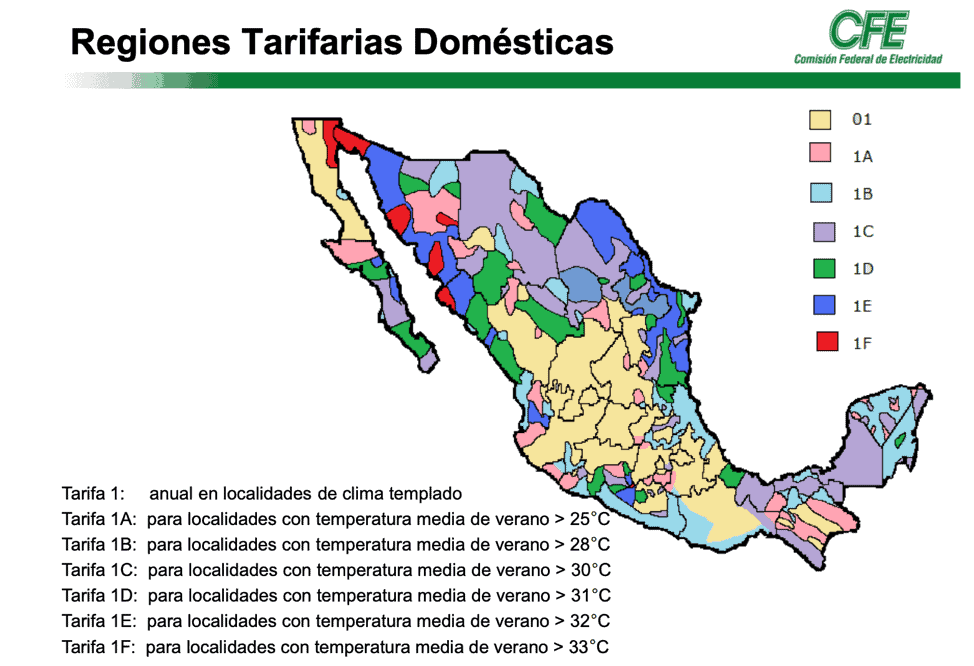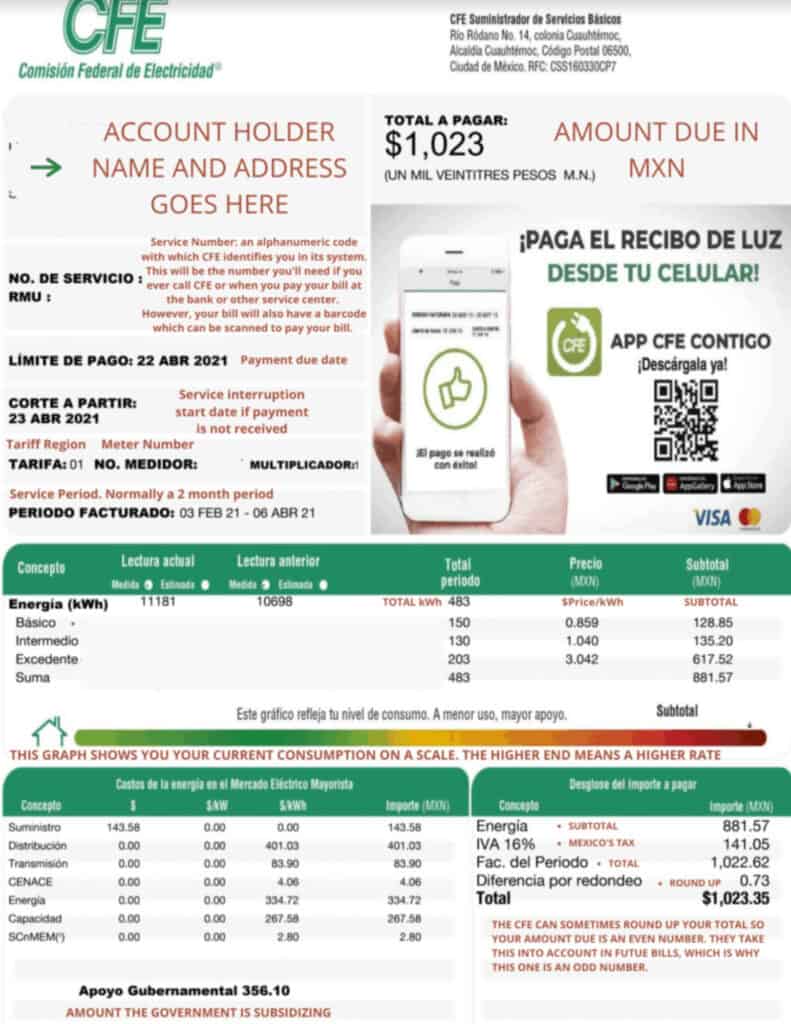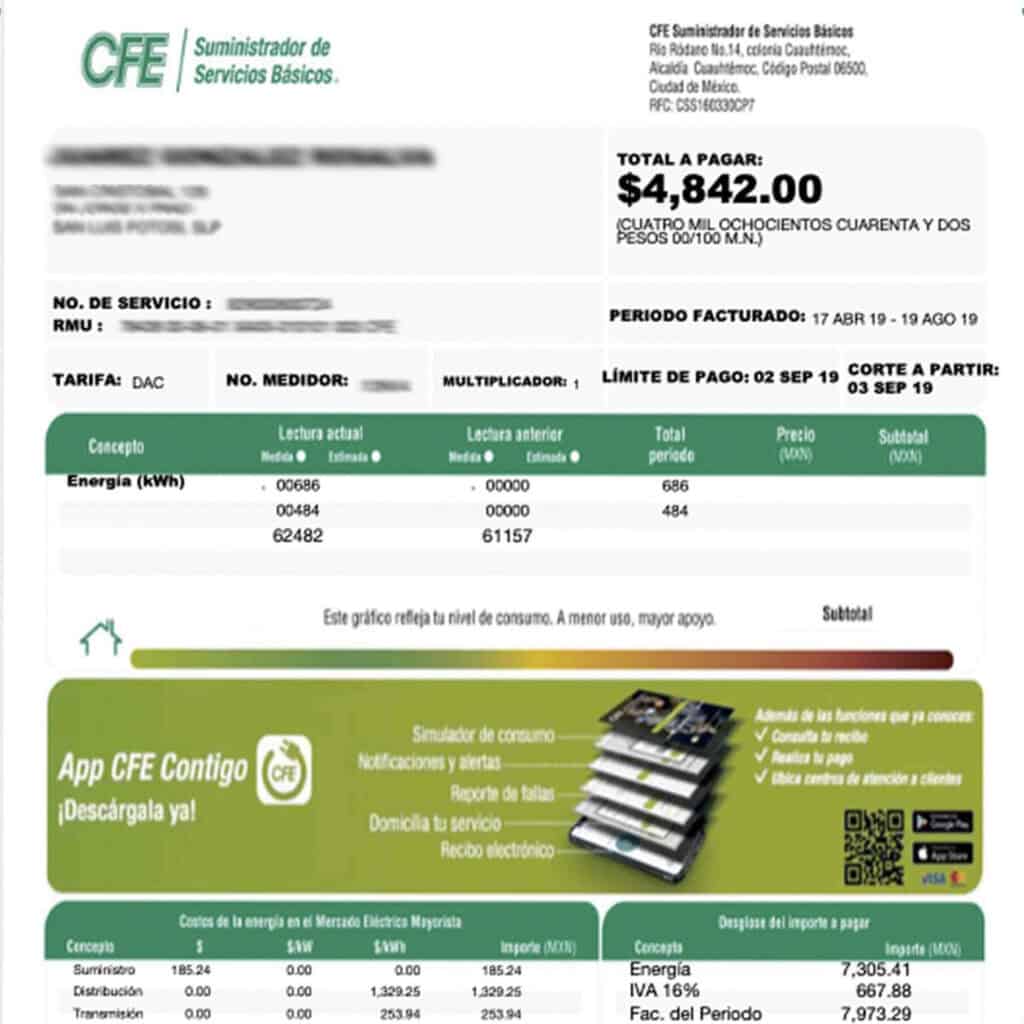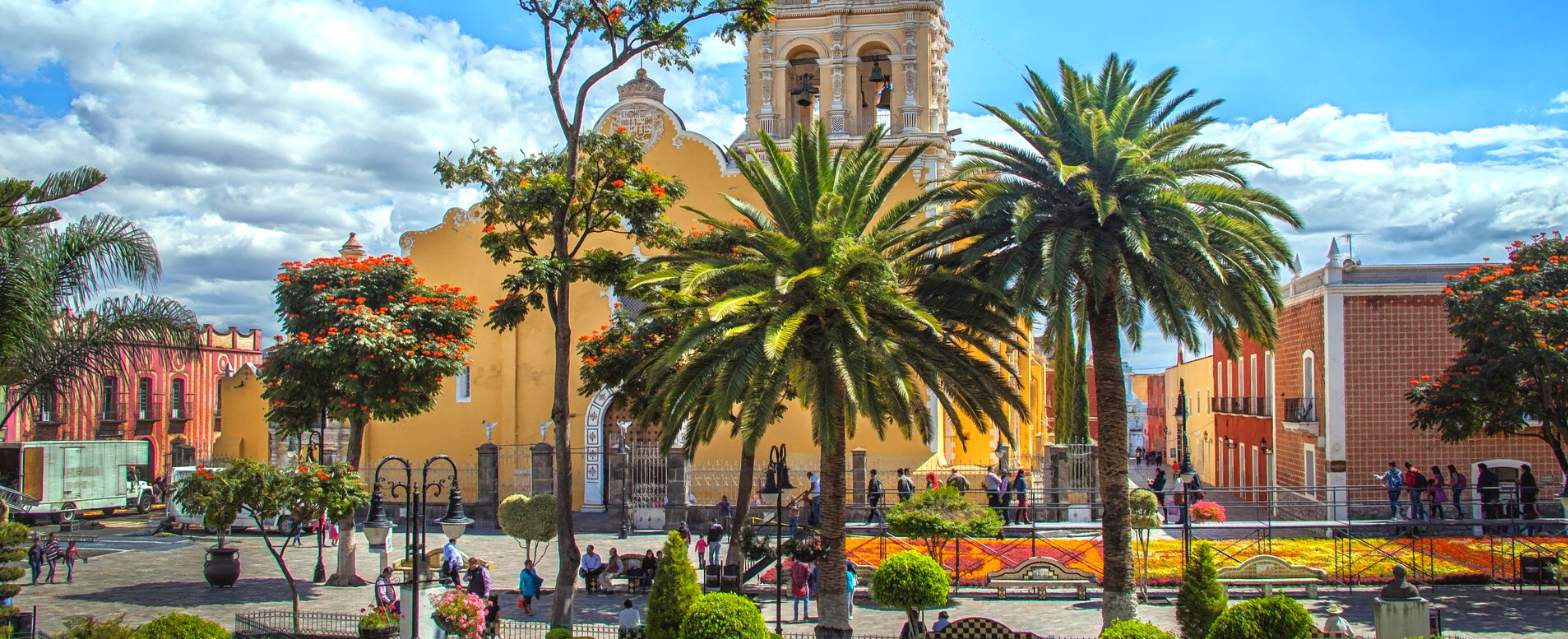Probably your most expensive utility in Mexico will be your electric bill. Comisión Federal de Electricidad or CFE manages your electricity in Mexico. It’s a non-profit public company that the Mexican government runs.
Your cost or “tarifa” will vary based on where in Mexico you live and what time of the year it is. That is because the CFE assumes that if you live in a hotter climate where the use of air conditioning is common, your electric usage will be higher than in Mexico’s central highlands. Therefore certain regions are charged different rates.
Domestic Rates by Region
The first thing you should do is determine which rate applies to you based on the city of Mexico you live in. This image shows the different rate categories in Mexico by region.

Rate 1A
This rate is designated tohomes in areas where the minimum temperature in summer is 25°C. Therefore, a larger intermediate consumption is allowed before the surplus is collected.
Rate 1B
It applies to regions with average summer temperatures of 28°C or higher. It’s also a domestic rate and has a monthly consumption limit of 400 kWh.It is best suited for users who require power for large refrigerators.
Rate 1C
Applied in areas with average temperatures of 30°C or more in summer.This rate is not high consumption and is supplied in low voltage.
Rate D1
It is a CFE rate that applies to areas with an average minimum temperature of 31°C in summer.The basic consumption of the 1D rate is 0.921 pesos for each of the first 175 kW/h
Rate 1E
It is a Domestic High Consumption (DAC) rate, and is for regions where the average summer temperature is 32°C or higher.With it, users can consume up to 2,000 kW/h per month.
Rate 1F
This is the rateIdeal for very hot areas, with temperatures above 33°C.It allows for the highest level of intermediate consumption, significantly reducing the impact of electricity costs.
DAC Rate
The DAC (High Consumption) Rate is the rate applied to households that consume more electricity than the CFE allows. It is higher than the basic and intermediate rates. If the letter “DAC” appears in the “Rate” section, then your home is on the DAC rate. I explain this below.
Why Your Bill Might Spike Suddenly (DAC Rate Explained):
In Mexico, the government helps lower your electric bill by providing subsidies in some states.
Which means you pay less per kWh, as long as your monthly usage stays below a specific amount. However, if your average monthly consumption exceeds this limit consistently, you’ll lose the subsidy and move into a category called Domestic High Consumption (DAC). This DAC rate is significantly higher and will sharply increase your electric bill.
Each region in Mexico has its own subsidy limits based on local climate conditions.
For example, in the central highlands, where temperatures are mild, the limit is lower. While hotter regions, like the coast, have a slightly higher limits. If you consistently go over these limits, you enter the DAC rate.
Below are the subsidy rate caps based on the region of Mexico you live in.
Tarifa 1: 250 kWh/month
Tarifa 1A: 300 kWh/month
Tarifa 1B: 400 kWh/month
Tarifa 1C: 850 kWh/month
Tarifa 1D: 1,000 kWh/month
Tarifa 1E: 2,000 kWh/month
Tarifa 1F: 2,500 kWh/month
If your monthly average electricity consumption is higher than their monthly cap, you will get charged a higher amount. This is known as a Domestic High Consumption rate or DAC (De Alto Consumo). The average monthly consumption recorded by the user will be determined by the moving average of consumption over the last 12 months.
When the user’s Average Monthly Consumption is higher than the domestic fee cap, you will be reclassified to the High Consumption Domestic Rate or DAC.
CFE Bills Are Issued Every 2 Months
Your CFE bill is delivered every 2 months or also known as “bi-mestral”– not monthly.
Most 2 bedroom households or apartments pay around $400-$800 MXN (about $20-$40 USD) a month in the central highlands where air conditioning is not common..
However, if you live in a hot area of Mexico, your bill will most likely be higher if you run an air conditioner or two. Most 2 bedroom houses with air conditioning spend about $1,000- $2,000 MXN every month (about $50-100USD)
It may sound confusing at first, but once you understand how to read your CFE bill, you will understand your KW/Hr usage and the fee you have to pay.
Example CFE Bill – With Explanation
Below is an example CFE bill for a 2 month period. This is for a 4 bedroom house in Mexico City with a family of 3. (My explanation is in red text:)

The easiest way is to check your electricity bill and find the section that says “Rate” generally located under the Payment Deadline, I leave you a photo of a CFE Bill as an example below. This receipt must indicate the word DAC in the Tarifa section, as shown in the following image:

How to Avoid the DAC Rate
To avoid slipping into the DAC category, focus on energy-saving habits:
- Turn off unused lights and appliances.
- Unplug phone chargers and other electronics when they’re not in use, since they use power even when turned off.
- Replace old appliances with energy efficient or inverter models, especially air conditioners and refrigerators.
- Consider installing solar panels – a long-term solution to dramatically lower your electricity bills and stay clear of the DAC rate.
You will have to go through another couple of months of low usage, for the CFE to recalculate your monthly average and bring you down to the regular rate if you have shown you are not overconsuming energy.
To learn more about the CFE’s fees and how they calculate DAC please visit their site.
Want more useful insights for living in Mexico THE RIGHT WAY? Get our FREE Living in Mexico Email Series and be one step ahead in your research for moving to Mexico.





